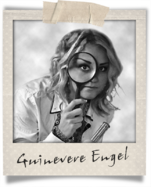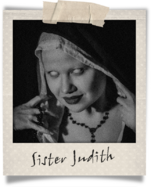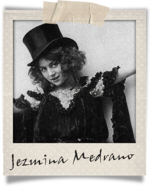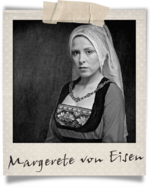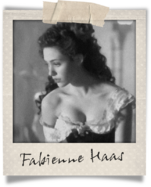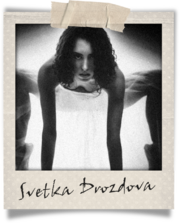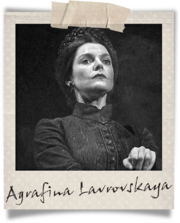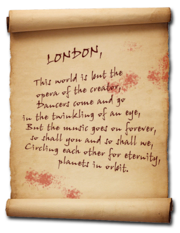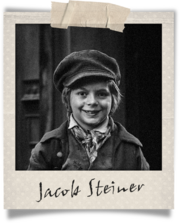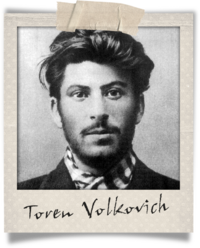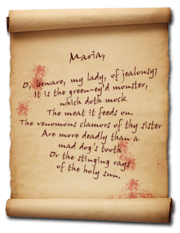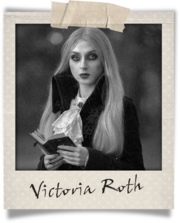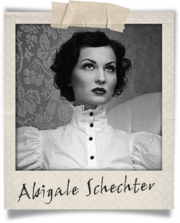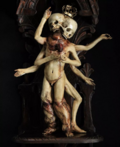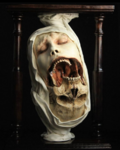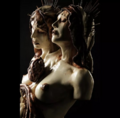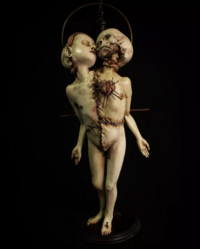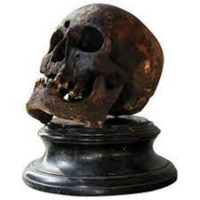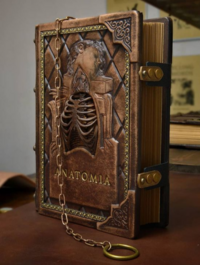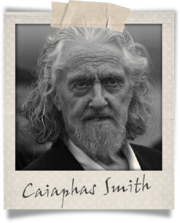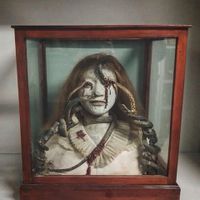2022-06-27
Jump to navigation Jump to search
INVOLVED PARTIES
INCIDENT REPORT
Rumor Has It...
Night falls across Vienna and the coterie starts away in their respective havens. This evening, Jezmina Medrano has climbed up out of the communal pit beneath the stage of the Birdcage Theater to find that her sister-of-sorts, Svetka, has peach blossoms woven into her hair, a manner in which she has never previously styled herself. Passing her snide sister in the dressing room, Jezmina goes to her Sire, Agrafina’s office to ask her about the goings on of late. She tells her that she’s been having problems with a stalker, and that the peach blossoms in Svetka’s hair might suggest that she is a target as well. Agrafina reminds her that someone trying to hurt either of them would be a fool indeed, as her daughters are as deadly as they are beautiful. She also tells Jezmina that the rivalry between herself and her sister is intentional, there is no better way to press them both towards greatness.
Upon confronting Svetka about the flowers, she learns that one of the staff was bringing them backstage and she took them, because who else could they be for? Besides, the poem was called London, and Jezmina was not even with the ballet when they performed in London. Jezmina warns her about the stalker, but Svetka is dismissive, implying that Jezmina simply does not know what devoted fan attention is like, since she is not worthy of the adoration like Svetka herself is.
The stolen poem reads:
London,
This world is but the opera of the creator,
Dancers come and go in the twinkling of an eye,
But the music goes on forever, so shall you and so shall we,
Circling each other for eternity, planets in orbit.
Across town on the campus of the Medical College at the University of Vienna, Doctor Engel wakes up to find that a note has been slid under her office door, it is simply labeled “Engel,” the German word for angel. It is sealed with silver wax embossed with a wolf’s head seal, upon opening it, Guinevere discovers that it is indeed from her Gangrel admirer, Professor Toren Volkovich. He is letting her know that he has gone to charter a carriage for their date to the Wonder Cabinet this evening and will pick her up at midnight from At the Skull.
Upon waking in the royal apartments, Margerete finds Gruber waiting for her, as expected. This night he informs her that he has been contacted by Victoria Roth’s man of business to extend a formal invitation to meet her at Count von Richter’s estate, The Golden Messenger, at her earliest convenience. As she heads out for the evening, she comes upon a bit of a ruckus, and she finds Duke Peter von Eisenhoff, her political rival, huffing away from a man she’s seen at court, but never met before. Duke Peter is cursing the petulant man for insulting him and says that if he were of a rank worthy of being noticed by him, he would call him out. But alas, only gentlemen of the same rank typically duel, and stooping to his level would damage Peter’s standing at court.
Margerete further insults Peter and he leaves in a huff, giving her a chance to speak to the mysterious young man who was so offensive to the Duke. She discovers that his name is Rudolf Belinsky, a minor Russian noble who has been sent to the Vienna court as a liaison. He admits that he finds Vienna tiresome, but at least things are happening, and it is not as cold and desolate as his native Russia. After she bids him good evening, Margarete remarks to Gruber that this man may be useful in her schemes against Peter, since it is better to play cat’s paws than attack him directly.
In the dimly lit halls of St. Stephen’s cathedral, Sister Judith performs her nightly ritual and then happens upon young Jacob. He has been looking for her to thank her for the extra rations of stew and bread, he’s feeling much better, broken arm aside, and has a message for her from Les Mouches. He says that they have been in contact with The Pawnbroker, he has the skull of Herr Mozart and is willing to trade it for a book that a client of his wants stolen from Konstantin Koppensteiner, the taxidermist in residence to the emperor, and Keeper of Elysium. They seem to believe that he holds a book known as the Milagres da Anatomia, which is somewhere in the Wonder Cabinet, and what a better night to steal it than this, the opening of his new gallery of anatomical oddities.
Sister Judith agrees to the price and tells him that she wishes for Les Mouches to start spreading a rumor that the Small Council knows the location of Haydn’s head and they are meeting At the Skull to discuss it. She wishes for Abigale Schechter, the Tremere attaché to the council to get wind of this important information. Jacob thinks this will be no problem, he is frightened of Les Mouches, but will do this for the Sister out of gratitude. Judith puts him back to bed, but not before giving him an extra dinner roll from the food cart in the patient ward.
Some Arcane Acoustics...
In her sound-proofed chamber, Fabienne Haas awakens to find her lady’s maid with a letter and armful of books sent by her friend Henri Marchande. He has written to tell her that since she requested information about the use of skulls in summoning spirits, but then did not show up to meet him, he made some notes and sent on the most pertinent information. The stack of old books now on her beside table are old and weathered, bookmarked and dogeared in places, bearing these titles:
- De Generibus Artium Magicarum
- Unaussprechlichen Kulten
- Exercitatio Magica Nobilissima
- Rational Thaumaturgy
- Liber Ivonis
The several pages following Henri’s initial letter contain many transcribed passages with citations from each book which all seem to be saying something similar, that skulls are often used in the summoning of spirits, some of the passages refer to them as “fetters” others call them “relics” or “phylacteries.” He sums up on the last page of his notes that since his specialty is in applying alchemy and hermetic principles to music, he believes that the Principle of Vibration is key here. He says, “Nothing rests; Everything moves; Everything vibrates, even the dead and other unseen things.” And suggests that perhaps what mediums and other summoners do is tune in to the vibration of the fetter, their trance like a tuning fork, helping them to find the correct pitch, in a sense. He proposes that in theory, anyone could tune in, but it would be more difficult for someone without some innate ability. His Catholic background also suggests to him that some skulls could certainly be more potent than others, such as venerated Saints.
Intrigued by his findings, Fabienne decides to pay Henri a visit, and he is most excited to see his dear old friend. She asks him about “Cassandra” and he believes that the reference might be to the Greek mythological seer and oracle. They discuss tuning into the resonance of specific skulls, and he suggests that some place with good acoustics could help increase the effectiveness of such vibrations, and that she herself, or possibly Allegria, might be able to find such a pitch with their exquisitely trained voices. When asked about the skull of Beethoven having special properties, he says he is unsure, however he knows that The Dowager was great friends with the late composer and may have more information about the whereabouts of his mortal remains.
On her way to rendezvous with her coterie, Fabienne meets a fan at a local café and slips upstairs with him at the room he rents there to perform some of his compositions. Her performance is so enrapturing that he begins to weep and in his suggestive state, she feeds on him, utilizing his passion to sway him into the sweet throes of her vampiric kiss. As he slips into the afterglow of her wiles, she suggests that he go see a composer she knows, the infamous Emmanuel Zahn, who just so happens to be her rival after she spurned a production of his years ago.
As the members of this unlikely coterie all arrive At the Skull, they discuss the happenings of the previous evening, with Judith admitting that she does indeed have the skull of Haydn. She and her Sire have been planning a ritual to use it for many years now and she has given it to him to prepare. Judith asks Doctor Engel who her Sire is, since it was not apparent at their initial meeting, and the doctor admits, even she does not know who made her. Margerete tells the group that she has been invited to speak with Count von Richter on Victoria’s behalf, since she was a witness to the debacle that was the séance and Fabienne agrees to go with her.
At midnight, a beautiful carriage arrives outside, and Professor Volkovich steps out wearing a new suit that he seems uncomfortable to be in. He steps inside and hands Doctor Engel a bouquet of wildflowers that he picked himself and she blushes as she takes them. He is obviously nervous as he asks if she is ready to head to the Wonder Cabinet, she says yes, and they head out in their carriage, with Sister Judith and Jezmina chartering a carriage of their own to follow shortly behind.
Halls of Bone...
The two parties arrive at the Wonder Cabinet to see a swarm of people flocking to the entrance, everyone who is anyone has come to see the new exhibit, including Emperor Franz Joseph I and Empress Elizabeth. They of course, arrived early in the evening with their entourage for a special private tour given by the royal taxidermist, Herr Koppensteiner himself.
The building itself is enormous, a former palace turned into this museum of sorts, used to house a microcosm of the world. It is common for many wealthy individuals to have their own private wonder cabinets, to display their myriad of collections from paintings and sculptures, to taxidermized animals, plant and mineral samples, and much more. The wonder cabinet conveys symbolically the patron’s control of the world through its indoor, microscopic reproduction. It is in and of itself, a form of propaganda.
Once inside, Toren and Guinevere make their through seemingly endless galleries of objet d'art, nearly every surface of the already ornate salons are occupied by preserved fishes, stuffed mammals, reptiles, amphibians, and birds. Curious shells and corals fill studiolo’s of built-in cabinets which can be unlocked and pulled down to reveal intricately fitted nests filled with mineral specimens, polished stones, pearls of various colors, shapes, and sizes, and various insects trapped for eternity in prisons amber.
They pass through rooms with walls covered completely in works of art and floors peopled with statues of marble, sandstone, and bronze. String quartets are dotted throughout the rooms, playing Viennese favorites from the very composers that they know, are making their way—in one form or another—back home to Vienna. One room is entirely filled with meticulously created miniature ships crafted entirely in gold, another holds cases of tiny buildings, with architectural styles from across the globe recreated here for the emperor’s pleasure and glory.
Several themed rooms display cultural curiosities from around the globe, with garrisons of mummies lining hieroglyphic laced walls, galleries draped in oriental tapestries and dotted with jade sculptures and Ming porcelain bowls, or treasures from the Americas, Aztec stone reliefs, stuffed jaguars, macaws, and tapirs, and the feathered crown of Montezuma.
An African gallery contains scenes set with a stuffed giraffe, elephant, lion, zebra, and at the center of it all, the preserved bodies of a small African girl, and Angelo Soliman, the once celebrated “Noble Moor” who was a founder of scholarly reform in the Order of Freemasons, and an influential member of Viennese high society. Now, and perhaps always, he is merely another possession of the emperor, dressed not in the finely tailored fashionable European clothes he once possessed, but a loincloth. This display disgusts Toren, and Dr. Engel can feel the muscles in his body all tense up as a low growl escapes his lips. He turns to her and says “This is disgusting! ’Outsiders’ will only ever be amusements and prizes to be displayed to them, won’t we? And to think, he invited me here himself, called me his esteemed colleague. This is not science; it is barbaric mockery."
Guinevere agrees and they leave this distasteful display to find where Sister Judith and Jezmina have wondered off to. They find the pair in the back of the museum, a labyrinthian collection of storage rooms full of crates with artefacts, skeletons, books, and stuffed animals of all kinds. They have been looking for Konstantin’s office, to liberate the book that Judith needs to trade for Mozart’s skull and Jezmina hopes to fund a suitable decoy skull among these halls of bone to send back with Abigale as the recovered skull of Haydn.
As they are searching for the office, a servant girl presses a bouquet of peach blossoms into Jezmina’s hand and before the girl could get away, the group stops and interrogates her. Sister Judith guilts her into admitting that she had never seen the man before, but he was so beautiful, and so intense, she couldn’t stop herself from doing what he told her to do. Doctor Engel is able to skim the poor woman’s surface memories and watches as a strikingly beautiful blonde man hands the girl the bouquet, dominates her, then leaves in an exquisite carriage, suggesting that he is not only rich and noble, but kindred as well.
This poem reads:
Maria,
O, beware, my lady, of jealousy;
It is the green-ey'd monster, which doth mock
The meat it feeds on.
The venomous clamors of thy sister
Are more deadly than a mad dog’s tooth
Or the stinging rays of the holy sun.
The Golden Messenger...
On the other side of Vienna, Margerete and Fabienne have arrived at The Golden Messenger and found a distraught Victoria waiting for them. She says that Count von Richter is furious that she lost the skull, but even so, he is too busy with preparations on the Opera House to punish her himself. Instead he sent Abigale to berate her, Victoria asks them to plead her case to the terse woman, perhaps she will believe such respected members of the Viennese court.
As they pass through the two great wooden doors into the library, Fabienne and Margerete notice that they are lfined completely with arcane sigils. Most likely wards, though neither of them can be sure what type of wards those in the upper echelons of Clan Tremere might have guarding their personal libraries. They find Miss Schechter in the great library standing over a desk full of arcane books and blueprints for the Opera House. Without turning to face them, Abigale chides Victoria, saying that instead of coming to her with more excuses, she should be out finding the skull, since it is vital to the Count’s plans.
When she turns to look at Victoria and finds Margerete and Fabienne at her side, Abigale’s face betrays her surprise before she attempts to smooth it over with practiced formality. She apologizes that Victoria has dragged them into her failure, remarking that a séance seems like a silly thing for someone of Margarete’s importance to attend. Gnädinge Frau Eisen responds that she likes to keep up on all the goings on in Vienna, and how could one miss the chance to see something like that, it was an interesting experience that she has not had before. She and Fabienne tell Abigale that they would love to assist her investigation and that they will find out what they can from their own sources and meet with the Tremere woman in two nights at a vaudeville theater where Fabienne used to perform.
Gallery of Flesh...
Back at the Wonder Cabinet, the group has managed to find Konstantin’s private gallery, workshop, and office. Inside they examine his sculptures of flesh and bone, which are heavily religiously themed, inspired perhaps, by his collection of various bibles, including an original Guttenberg printing. The first piece in this gallery is entitled “Holy Child of the Plague." Another is called simply, “Pious,” its small name plate giving only a simple bible verse as exposition. Beyond that is “Mors Tua, Vita Mea” which is accompanied by a short poem. The next is entitled “Miseri et Tristi,” its verse speaking of the Dark Mother.
There are many more such pieces lining these dark walls, some in various states of completion, the one currently on the work bench has many bits and pieces of body parts lying around it and an open notebook nearby reads: “The Apology: this will be my version of Cain and Abel, it should resemble the duality of nature and as always, what we can see in a brother, that is also the duality of life and death. An infinite circle, there should be a rusted halo bonding the heads, holding the faces like they are about to kiss each other on the cheek as a symbol of forgiveness, or as we know, the other side of the coin, a symbol of treason.”
As they are looking over the sculptures and the worktable, Jezmina asks Professor Volkovich to pick out a skull from a cabinet of extras that might work as a suitable decoy to give to the Tremere. He peruses the collection and finds one of the appropriate age and level of deterioration as the late Haydn’s skull would have had and Jezmina pockets it for future use.
A large desk looms in the back corner of the room, perched in front of a wall of bookshelves, like it is a great beast guarding the many tomes. On the desk are inventory sheets from the many galleries, letters of correspondence between Konstantin and other museum curators and various books of anatomy and medicine. Sister Judith places the Guttenberg Bible back into its place on the shelf of religious texts and a secret compartment clicks open. She is able to slide the entire bookshelf to one side, revealing a small hidden compartment that contains two books, a shard of petrified wood, and a small vial of reddish brown liquid that smells like blood.
Sister Judith inspects the books inside, one of which is the book she is after, the Milagres da Anatomia, the other is a notebook bound in black leather with gold embossed writing on the cover which says “Project Nepri.” Inside are intricately detailed anatomical sketches, many of which appear to be showing methods of reconnecting severed blood vessels, muscles, and nerves. The text seems instructional, and for the most part, medical, however there are several arcane touches sprinkled throughout. Towards the back of the book are some sketches of a woman’s face that Judith notices look eerily similar to Doctor Engel’s.
A True Believer...
As they are inspecting these finds, someone enters the office door, a figure cloaked in dark colors and hunched over as though they are sneaking in appears as they all turn to look. As the figure carefully shuts the door and turns, they can see that it is an old man, his graying hair and wrinkled, sun-worn face suggests an age of at least sixty. He looks surprised at first upon seeing the gathered group all, but then furrows his brow a bit and scratches his white beard with a sigh. He asks if they are minions of “the Butcher” or if they are here to steal from him as well.
Sister Judith asks what he is here to take, and to her surprise, he admits that he’s after the shard of The True Cross, as the one on display out in the galleries is a fake. As he is talking to her, he walks closer to the group, and they all start to feel a bit sick, a strange pull in the pit of their stomachs turns ever tighter with each step he takes. Doctor Engel notices that somehow, Sister Judith is the only one seemingly unaffected by whatever power this man wields, a power that radiates from him like a golden halo. For her part, Sister Judith knows exactly what is happening, as those who possess True Faith are rare, but not unknown to her.
Jezmina makes her way around the edges of the room, hoping to get the jump on this strange man with his strange power, but he and Judith manage to strike a deal, he’ll take the shard, and in exchange, he gives them the skull of Sir Thomas Browne, renowned doctor and author of Religio Medici, a spiritual testament and psychological self-portrait that used scientific imagery to illustrate religious truths as part of his discussion on the relationship of science to religion and created a philosophy that sought to bring the sciences into harmony with God. Toren inspects the skull and believes that it is indeed authentic, as he has previously seen it on display of the great thinker’s former teaching hospital in London.
Upon his exit, the effect that the strange man was having on them fades almost as quickly as it started, and they take their leave of Konstantin’s office also. As to not appear suspicious, the group winds their way through the new anatomical anomalies exhibit and the arcane curiosities hall as well, Sister Judith takes special notice of a piece there, entitled The Punished Suicide. This “sculpture” of flesh was created by anatomist Lodovico Brunetti in Italy and acquired by Konstantin at an unimaginable cost. The work features the preserved bust of an unnamed young lady who jumped to her death in the icy waters of the river Bacchiglione in Padova, right behind the hospital where dottore Brunetti worked. Her golden hair floats like a halo around her head as tannin-preserved snakes constrict her neck and tear at her face and eyes. Red wax serves as theatrical blood in this allegory of the punishment reserved in Hell to those who commit the mortal sin of suicide.
Regrouping At the Skull, Sister Judith pulls the doctor aside to show her the book with her picture drawn in it and Guinevere immediately recognizes the information within as the same procedure that she has been working to develop. The doctor then asks Toren for his opinion on what the most important skull he’s ever seen personally, and he excitedly says that this newly acquired skull of Sir Browne is quite the find. She concurs, then bids Toren good evening as he politely asks to kiss her goodnight. She allows it, and the two exchange a sweet goodbye before Margerete comments coldly that she should be careful, as they all should, about who they fraternize with.
The group parts ways after making plans to meet up again the following evening and on her way home, Jezmina feeds on a stray working girl, taking almost all her blood. Before disappearing into the night, she pulls her to the edge of the alleyway and leaves her propped up, in hopes that some of her compatriots will find her and get her home.
MUSIC FROM THE WIENER STAATSOPER

